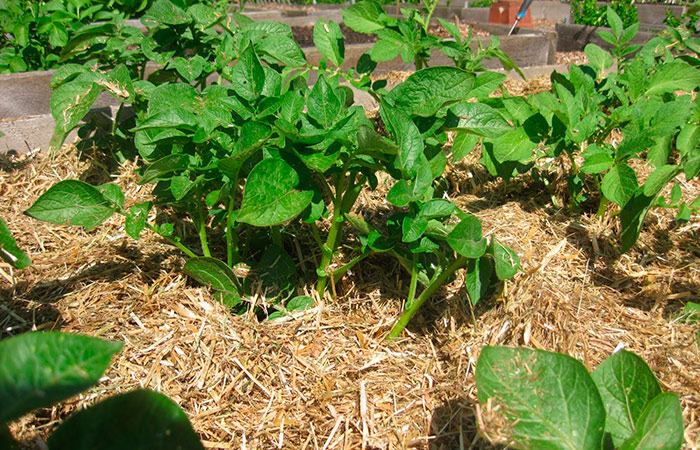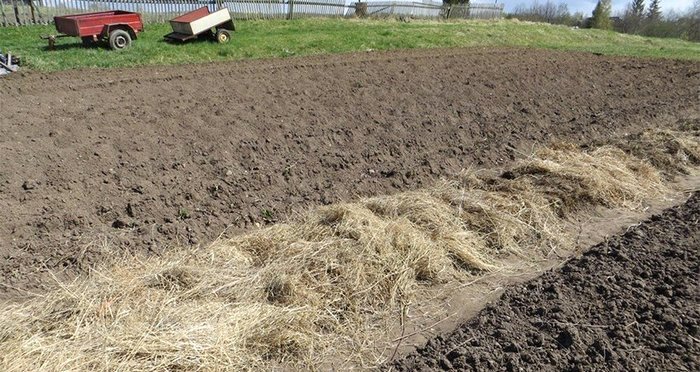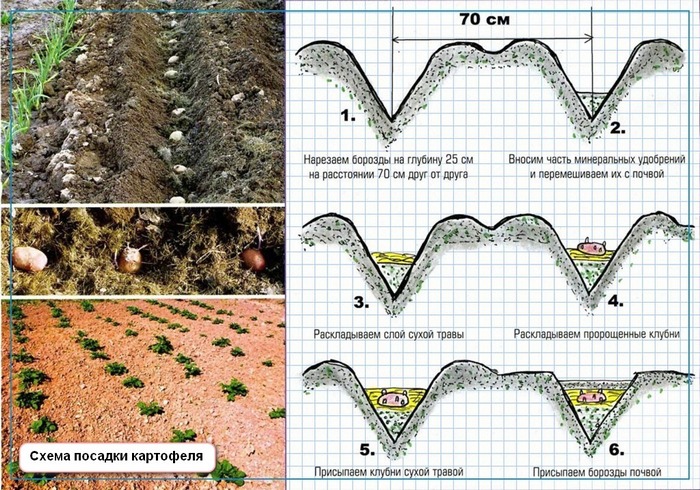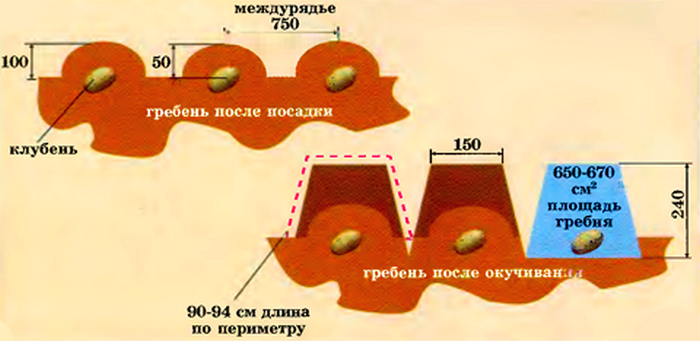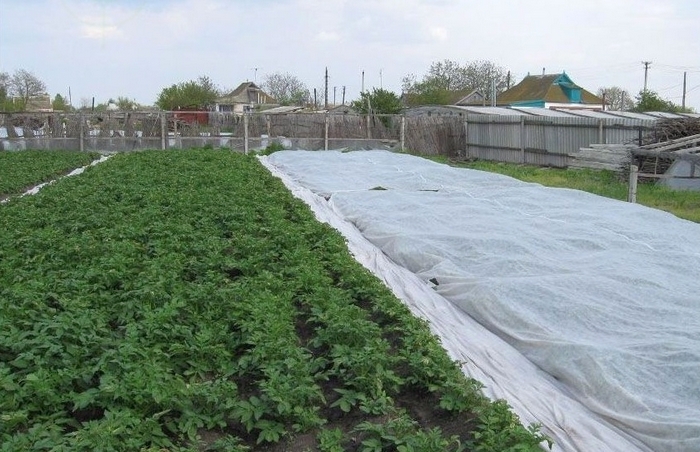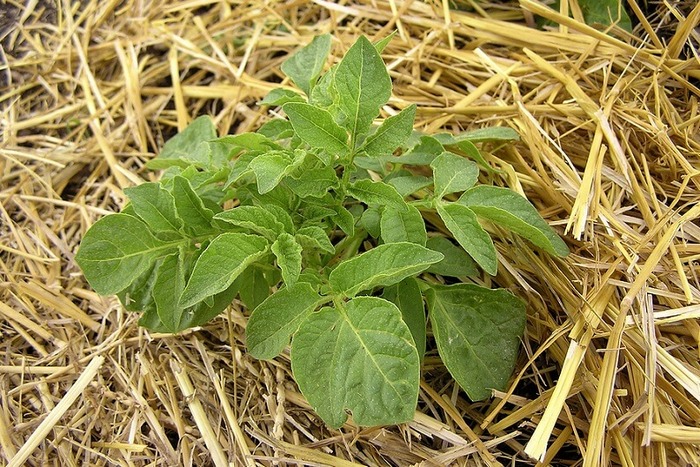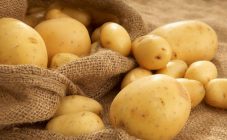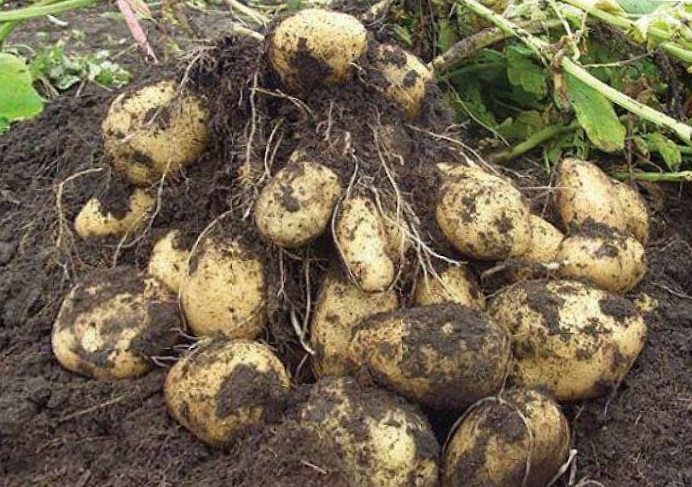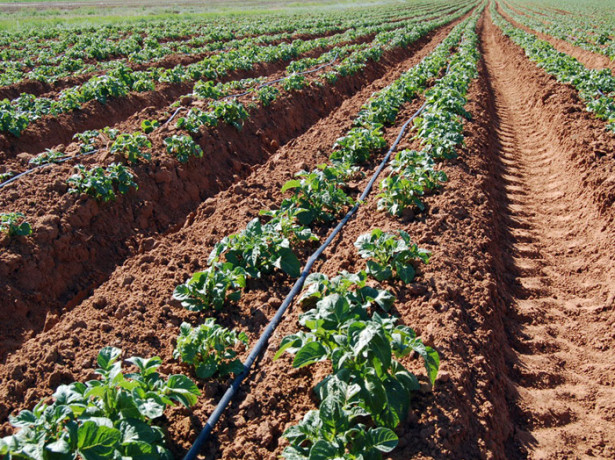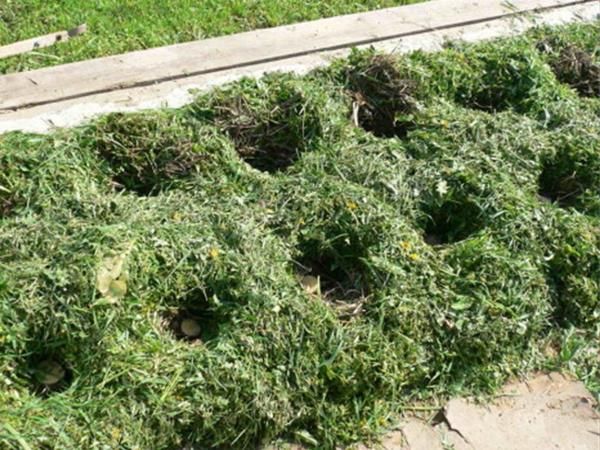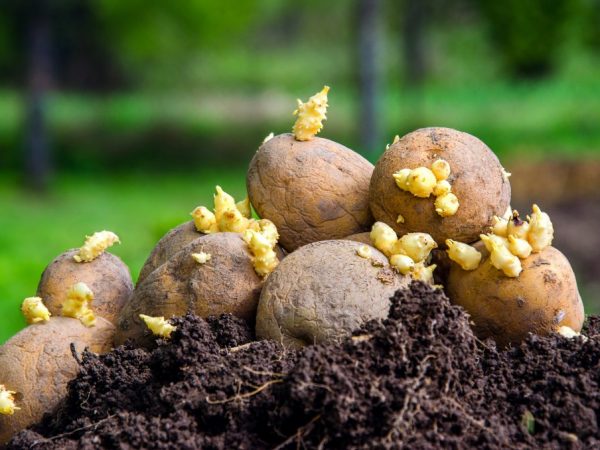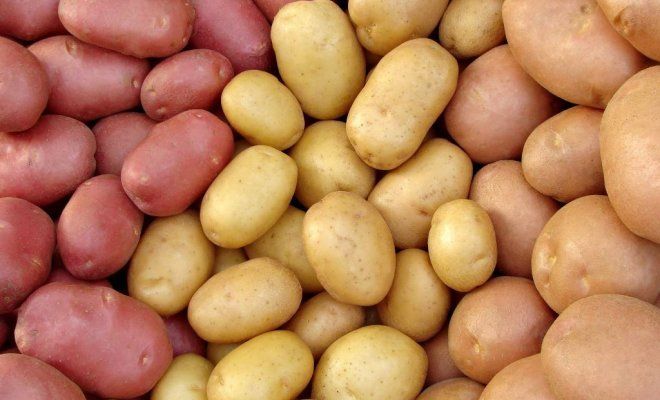Content:
Starch tubers are used in first courses, side dishes and even for making desserts. Some summer residents on their lands grow exclusively potatoes, giving them preference over other vegetable crops.
A biological feature is the presence of tubers, which, in fact, are nothing more than modified shoots. And the eyes are the buds of the plant, thanks to which potatoes are grown.
"Innovative" planting technique - under hay and straw
The traditional method of sowing tubers was practiced by all gardeners. Therefore, they know firsthand how laborious the process is. Yes, and you have to spend a lot of time and effort on follow-up care. Modern potato growing offers a creative approach - without the use of shovels, which was used by distant ancestors.
Planting potatoes under straw (or hay) for some reason was forgotten for some reason, although it greatly facilitates the summer resident's work, eliminating a number of tedious elements of agricultural technology. The first stage is the preparation of the site, you cannot do without a spade, because in the fall it is advisable to dig the garden bed to the depth of the bayonet with the overturn of the earth layer. This will clean the weeds and get rid of the insect larvae.
Many gardeners know how to properly grow potatoes under straw. Therefore, several cultivation methods have been developed. Everyone chooses the most acceptable option for themselves, based on the characteristics of the suburban area, region, their own capabilities.
Potatoes are grown under hay in almost all regions of the country. Agricultural technology will be successful if you choose the right variety for the climatic conditions of zoning.
Both small beds and large plantations are planted under straw. It all depends on the amount of covering material under which the potatoes will ripen. Not everyone can afford a large supply of hay.
The methods of growing tubers discussed below help you meet 3 main factors for a good crop.
The main conditions of agricultural technology
| Factor | Features: |
|---|---|
| Optimum temperature | Hay and straw maintain the right balance, preventing the tubers from overheating or freezing (even in regions with a limited growing season) |
| Looseness of soil and moisture | The covering material is a mulch that protects the soil from weathering and rapid evaporation of the liquid; in such conditions worms feel comfortable, the main "job" of which is to loosen the earth |
| Nutrition | The straw “blanket” is saturated with microelements; when the lower layers decay, they become a good feeding for potato beds |
In addition to these features, the technology has other advantages:
- a thick layer of mulch prevents the weeds from breaking through, which frees summer residents from weeding;
- useful insects develop in hay and straw, preferring to feed on Colorado beetles; potato bushes, thanks to this, will be less damaged;
- planting tubers and harvesting are carried out manually, so you don't have to make any special efforts; with this method, less time is spent on work compared to the traditional method;
- potatoes grow not only large, but also clean, without clods of earth.
The straw technique is good, but there is also a "fly in the ointment" here:
- hay attracts slugs, and straw attracts rodents who like to eat potatoes;
- it is not always possible to purchase a sufficient amount of covering material, and under a thin layer of mulch, the tubers will turn green and lose their nutritional value.
The disadvantages can be called secondary, not outweighing the advantages of the technique. It is easy to deal with pests by spreading gravel and eggshells from slugs along the beds, and poison against rodents. It is recommended to compensate for the lack of straw by other methods of shelter, which will be discussed below.
Growing technology under straw
Most summer residents use the simplest version of planting tubers that was once practiced in Russia. Therefore, it is called the most commonly used classical method. When planting potatoes under straw, the farmer gets a garden without hassle, getting rid of the tedious work of growing crops.
The sowing season is started using this technique at the same time as with the traditional method: when the air temperature becomes constant and does not drop below plus 8 degrees.
Conventionally, the method of growing tubers can be divided into main phases.
Stage 1 - preparatory
The beginning of any planting is the preparation of seed material. For the method, the best tubers are the size of a hen's egg and well-developed eyes. Germination of sprouts is carried out in April-May (depending on the specific region), this is done according to the following algorithm:
- seed tubers are placed in low wooden boxes with ventilation holes;
- installed in a sufficiently well-lit, well-ventilated room, where the temperature is maintained on the order of 10-15 degrees Celsius (veranda, closed loggia);
- periodically, the boxes are turned 180 degrees - this will allow the ultraviolet radiation to be evenly distributed between the potatoes.
When the sprouts are strong enough and the weather outside is suitable for planting, the seed potatoes are sent to the garden bed.
Stage 2 - landing
Planting tubers will take a little time, one person can handle it quite well. The step-by-step algorithm looks like this:
- using a twine marker, mark the rows, keeping the space between them at 70 cm;
- tubers should be placed on slightly damp soil; if the need arises, it is recommended to water the area allotted for a potato plantation (but not abundantly) from a hose;
- lay out the tubers in the designated strips, observing a step of 30 cm;
- sprinkle potatoes with wood ash.
It remains to cover the rows with mulch, the thickness of which should be at least 25 cm, and even 30-35 cm above the tubers themselves.
Plantation care
The subsequent actions of the gardener are reduced to caring for the potato beds. True, at first you will have to wait a long time for the tops to hatch over the straw. The thicker the covering layer, the longer the process takes.
The main points of growing potatoes are similar to traditional ones, but much simpler:
- there is no need to huddle the bushes, but you will have to put straws around the grown seedlings; the first mounds form when the tops grow 15-20 cm; the procedure is repeated 2-3 times;
- from time to time, mulch should be raked (on small beds - by hand) so that it does not thicken, otherwise air exchange will be disrupted and the crop may die;
- the plantation is periodically watered (but not waterlogged); from a lack of moisture, tubers develop poorly and lose their presentation;
- as for dressings, in this case they are not necessary - mulch copes with this mission perfectly.
After 3 months from the moment of planting the seed, you can already sample the young potatoes. To do this, it is enough to rake out the straw, take the largest tubers, then carefully cover the bush again, allowing the remaining fruits to develop further.
There are several other interesting options, different from those already described, which should be paid attention to.
Alternative options
The classic under straw method is good for large plantations if you have enough covering material at hand. But you can also resort to other methods of hay and straw growing potatoes.
Symbiosis of tradition and classics
This method requires loose soil - you will have to make furrows in it using a hoe. With the same tool, small indentations (5-6 cm) are marked in the grooves for the tubers. The planting scheme is kept according to the traditional one.
Tubers are laid with sprouts upwards and sprinkled with a thin layer of earth. A dense layer of straw or hay is poured over the site. At the same time, there is no need to select rows - the "blanket" is distributed evenly throughout the plantation. The rest of the care is no different from the classic option described above.
Combs under the straw
When there is very little straw, the combed method is suggested. Forming holes for potatoes, ridges are made in parallel, 10 cm high.The width of the strip should be about 20 cm.
Having laid the tubers in the ridge holes, they are covered with straw. It is also distributed between rows - to retain moisture and suppress weeds.
This method of growing mulch requires little - the ridges protect the potatoes from the sun's rays. Earthen ridges will prevent heavy rains from washing the bushes from the beds, which is convenient in areas located at an angle.
As the tops grow, as in the previous versions, it is necessary to form straw mounds around the bushes.
Cardboard option
Some gardeners on small plantations compensate for the lack of hay with a cardboard cover. In this case, you need to start by laying the cardboard on the garden bed. Along the perimeter of the future landing, a border is made of boards in such a way as to exclude the slightest cracks under the shelter.
Next, perform the following actions:
- with a marker, place places for tubers on paper material, observing the usual scheme; if the beds are narrow, then in parallel rows you can use the "chess principle" of placing potatoes;
- at the marks, X-shaped cuts are made and the edges are unbend;
- a tuber is placed in the open opening and the corners of the cardboard are partially returned to their place;
- when shoots appear above the shelter and grow a little, the garden bed is covered with straw.
Ancillary material is a great way to get a good harvest at low cost. This option is suitable for gardeners who periodically appear in the country. Their only concern will be to add straw to the garden bed and moisten it from time to time. A cardboard and straw shelter will provide order in the garden, completely ridding potato plantations of weeds.
Harvesting covering material
Before you try planting potatoes according to the old-fashioned methods, it is recommended to weigh your possibilities. First of all, you need to decide where to get the covering material. Fortunately, there are agricultural companies selling straw bays.
If a summer resident cannot afford purchased hay, he is able to prepare it on his own. Someone will walk along the local meadows with a scythe, but raw materials can be grown on their own plot if the land area has large areas.
It is rational to divide the potato plantation into 2 equivalent "branches". One area will go directly under the tubers, on the other - from early autumn, nutritious crops should be planted: peas, oats, vetch. You should not dwell on one type - the earth will receive more useful elements from the plant complex.
In autumn, green manures are not removed from the plantation, and they do not need to be buried. In the spring, after the snow melts, after waiting for the lodged grass to dry, you can plant the tubers. Having formed small holes under the straw, sprouted potatoes are placed in them, sprinkled with a small layer of earth, humus and covered with hay.
This method of growing potatoes under hay and straw can significantly reduce labor costs, save time and increase yields.
Straw planting results
Those who have already tried growing potatoes under straw assure that the result exceeded expectations. From one bucket of planting material, you can get at least 5-6 buckets of large tubers. This is only with limited agricultural technology. If you create the most comfortable conditions, then the potato plot will reward you with a large harvest.
In the southern regions, growing using this method is easier than ever, but in the Moscow region and more northern regions, you will have to worry about an additional covering layer of straw to avoid freezing of potatoes.
In these regions, a more suitable technology is straw-bed technology. With her, less hay is needed than usual, and the bulk land will maintain an optimal temperature. If you also lay a layer of humus under the straw, then the yield can be doubled.
Having tuned in to the "new" method of planting potatoes in the country, borrowed from their ancestors, each farmer will choose for himself the straw option that suits him best for the size of the land plot and always taking into account the regionality.
